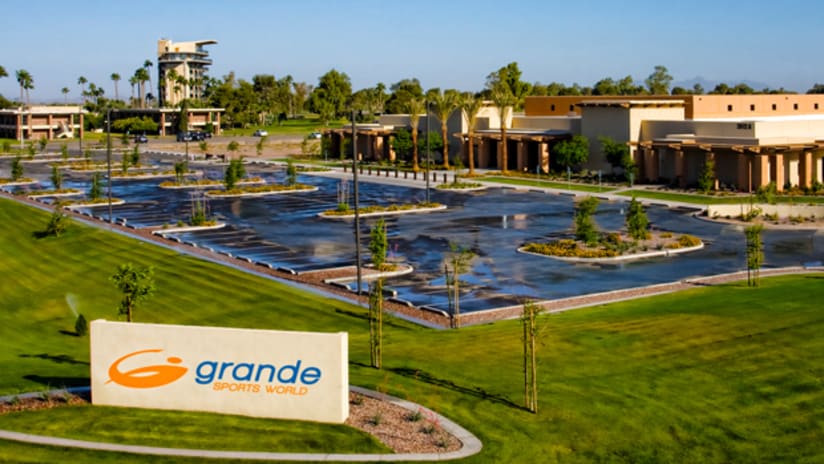In the world of soccer, developing young players by bringing them through the academy ranks and into the senior team is not a novel idea. But for Real Salt Lake, their newly announced RSL-Arizona Academy team is something of a revolutionary concept.
Back in 2006, the league announced its Youth Development Initiative, which essentially required all MLS teams to establish an academy system. In return, teams could have an opportunity to protect players from selection by other teams in the SuperDraft and it gave clubs extra roster spots that wouldn't count against the salary budget. Plus, clubs retain the rights of those academy players they sign and acquire a far greater portion of a transfer fee should those rights be sold to an overseas club.
For RSL, however, what is most notable is the club's groundbreaking approach to youth development. For starters, RSL's academy is a full residency program — the first of its kind in MLS. Other residencies that compare in North America include the esteemed IMG Academy in Bradenton, Fla., a program in Minnesota and the Vancouver Whitecaps' long-established academy.
[inlinenode:324846]"As soon as it was announced that we were going to start our academy, we started fielding calls from a lot of coaching directors in various parts of the Southwest [with prospective players], and we thought, ‘Wow! This is really going to push this residency thing into fast forward,'" said RSL academy director Greg Vanney, a former MLS veteran and US national team defender.
The academy is located out-of-state at a sprawling resort complex in Casa Grande, Ariz., and boasts 22 resident players and a handful of "commuter" players who live in the nearby Phoenix area.
Having a residency program allows the club to draw players from greater distances into their system, so it may seem like RSL are gaining a competitive advantage. However, Vanney sees it as just leveling the playing field with clubs such as the LA Galaxy, who have a far greater number of talented players living locally.
Traditionally, MLS clubs are granted certain local geographic regions from which to draw upon for their youth programs. But because of the low density of talent in Utah, Real Salt Lake were also given Arizona as a territory.
Of course, with a residency model comes costs — and they can be substantial. According to Vanney, these costs are primarily absorbed by Real Salt Lake. However, the program also has its own sponsors, and the participants' families also have the responsibility to help pay for players' room and board, depending on their ability to do so.
This high-cost aspect may raise an important question in MLS player development — that of transfer fees for developing players. This is relatively new ground in this country, which doesn’t have the history of developing players and then selling their rights — a common practice throughout the rest of the soccer world.
[inlinenode:324847]“First of all, the first team saves money because they don’t have to go and pay for a transfer fee to bring in somebody who can make a difference for their team," Vanney said. “You can continue to develop them and nurture them, and then move them on, and receive a value for developing them. It clearly gives greater business significance to the player development side. Again, this is a brand new concept.”
Last week, RSL's academy teams participated in their first big event: the Winter Showcase, held in nearby Phoenix. Both the U-18 and U-16 squads showed well. The U-18 team had two wins and a draw, including a stunning 7-0 victory over IMG academy. Meanwhile, the U-16 team tallied two draws and one win.
“A lot of our players before the showcase, nobody knew who they were," Vanney said. "Now, after the showcase, a lot of people know who they are because they did well for themselves. They came from smaller markets, and people hadn’t noticed.”
Vanney singled out a few of these players, including Maikon Orellana, who is from Provo, Utah.
“He came into this showcase and scored four goals the first game," Vanney said. "He’s strong, he’s very technical. He can run by guys with the ball, he can hold up the ball and he’s proven that he can finish.”
There have been rumors that the El Salvador national team is showing interest in Orellana, and the forward is one of a number of players who could ultimately be the first in the academy program to earn a Home Grown contract with Real Salt Lake.
“What we’re able to do given our [residency] setup really is setting the stage for the future of the sport, and I’ve heard that now from a number of academies, most of them being MLS academies," Vanney said. "Hopefully we’re just making American soccer, in our own way, better — and pushing it forward. If we’re doing that, we’re doing our jobs. Our No. 1 goal is to make players better.”
Think you know the game? Test your powers of prediction with MLSsoccer.com's new fantasy game,Pro Soccer Picks. Play NOW!













